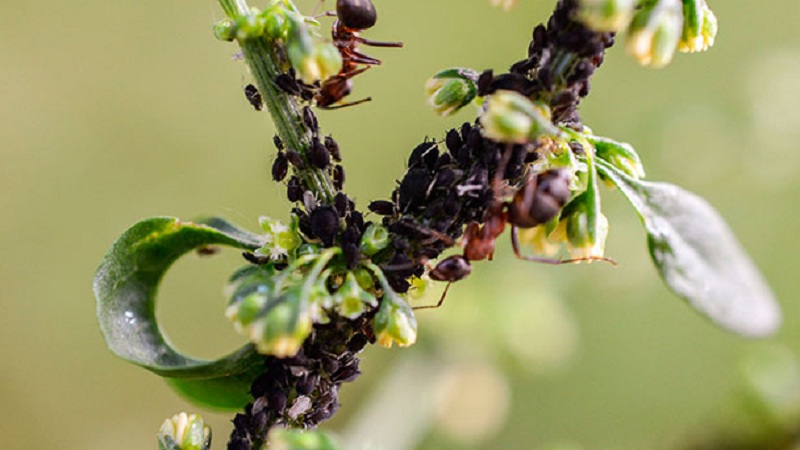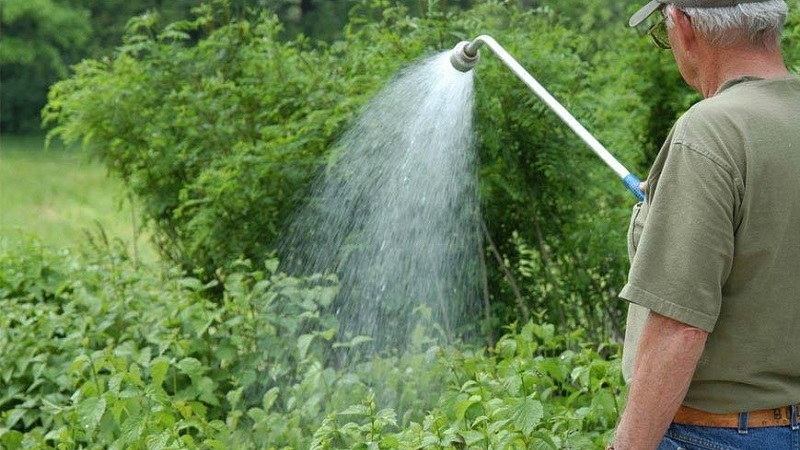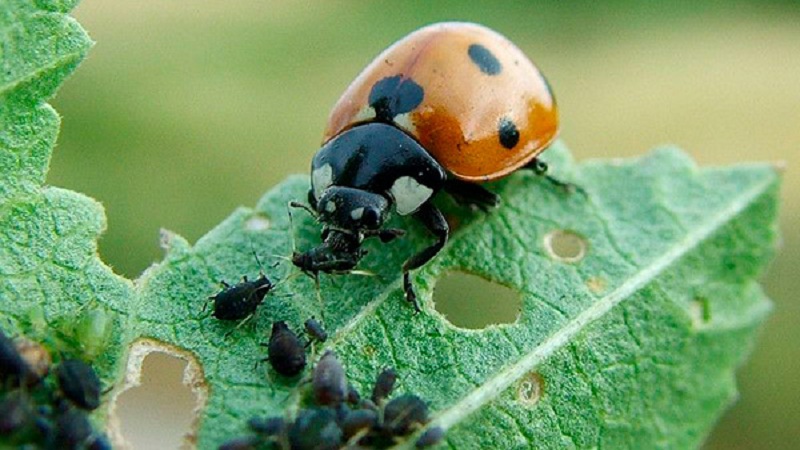Aphids on honeysuckle: how to process so as not to ruin the crop
Aphids cause a lot of trouble for gardeners and gardeners. Insects feed on plant juices and do not differentiate between cucumbers and fruit bushes. Small bugs spread with lightning speed. Whole colonies of insects are visible on the back of the leaves and on the shoots. How to deal with aphids on honeysuckle and how to prevent the spread of the pest, we will tell in this article.
The content of the article
How to treat honeysuckle from aphids
Perhaps every gardener is familiar with the problem of the appearance of aphids on the site. Small insects with black or green bodies are real gluttons. They attack fruit and vegetable crops, flowers, trees and shrubs.
It used to be that honeysuckle was not susceptible to aphid infestation, however as the shrub spread in different regions, the culture lost its ability to resist the pest.
The plant infects several types of aphids:
- Apical attacks the upper foliage, causing it to curl and dry. Aphids often affect Tatar honeysuckle. Signs of damage are visible to the naked eye: shoots stop growing and begin to branch. Such a phenomenon is called "witch's broom". The shrub becomes sloppy and loses its decorative effect, not to mention the loss of health.
- Honeysuckle-spruce actively eats foliage, which makes it turn yellow, dry and acquire a brown tint. Most often, it affects the branches of blue honeysuckle, Tartar and Ruprecht.
- Honeysuckle-cereal damages young branches. Soon they become deformed, stop growing, and internodes shorten. Leaves turn yellow and curl downward or curl obliquely across. Insects affect all types of shrubs.
The main source of food for aphids is vegetable juices.... Without them, the bush cannot fully develop and quickly loses its former beauty. To fight insects, gardeners use a whole arsenal of effective tools. Chemical and biological preparations are used, as well as folk remedies based on plants and scrap materials.

Folk remedies after flowering and during fruiting
What to do if on honeysuckle attacked by aphids? Folk remedies are the safest way to treat bushes... They do no harm to humans, bees or birds. The maximum efficiency is shown at the beginning of infection. The funds are allowed to be used during flowering and active fruiting of the culture.
Let us give recipes for the most effective folk remedies according to gardeners:
- 100 g of tobacco shag per 1 liter of warm water. Insist for 24 hours, then boil for 40 minutes. Filter the broth through cheesecloth folded in two layers, and mix 40-50 g of laundry soap for better stickiness. Spray the bushes 3-4 times with an interval of 10 days.
- Finely chop 300 g of garlic or garlic arrows and infuse in 1 liter of warm water for 2-3 hours. After that, filter the infusion, dilute with 10 liters of clean water and mix in 40 g of soap shavings. Use the ready-made solution for spraying bushes in the evening. The frequency of treatment depends on the degree of plant damage. The interval between sprays is 10 days.
- Chop 1 kg of tomato tops and cover with warm water overnight. In the morning, filter the infusion through cheesecloth and dilute with clean water by half. Use the solution to treat bushes, especially the back of the leaves. The number of treatments is 3-4 after 10-12 days.
- Pour 200 g of wood ash with 10 liters of water, leave for 24 hours and strain through cheesecloth.Stir 50 g of soap shavings into the solution and use immediately to spray the bushes. The tool is allowed to be used during the period of fruit formation, it does not affect taste and the appearance of the bushes. Treatment frequency is 3-4 times every 10 days.
- Pour 500 g of dried marigolds with 10 liters of warm water and insist until a putrid smell appears. In the infusion, mix 50 g of shavings of laundry soap and use the solution to spray the bushes. Gardeners recommend wiping the trunks with a solution to enhance the effect. The frequency of treatment is 2-3 times after 14 days.
- Grind 700 g of potato tops and pour 10 liters of hot water, leave for three days and filter. Stir in 50 g of soap shavings before use. The frequency of spraying is 2-3 times every 10-12 days.
- Finely chop 200 g of onions with husks and pour 10 liters of warm water. Leave for 24 hours, filter and add 40 g of soap shavings. Treatment frequency is 3-4 times every 10 days.
- 300 ml of vinegar or 100 ml of ammonia pour 10 liters of water, add 25 ml of liquid soap (cosmetic or tar) and process the bushes twice with an interval of 7 days.
- Dissolve 50 g of table salt, 50 g of baking soda, 100 g of shavings of laundry soap in 10 liters of warm water and immediately process the honeysuckle. The frequency of spraying is 2-3 times after 14 days.
Some gardeners collect aphids by hand or rinse with water from the garden hose.

Chemicals
How to treat aphids on honeysuckle? Chemicals used to destroy the pest on the bushes in early March and until bud break... The most effective drugs are:
- Actellik;
- "Confidor";
- Rogor;
- "Karbofos";
- Trichlormetaphos 3;
- "Keltan".
Their action is aimed at destroying the eggs of aphids that hibernate in the soil and on the lower branches.... Mature individuals die instantly. Contact insecticides remain effective for 25-30 days.
Important! The bushes are irrigated in the evening after sunset to prevent burns. To increase efficiency, the bush is covered with plastic wrap, and removed in the morning.
Biologicals
Biological preparations have a strong effect and are safe for humans and the environment... They can be used after the leaves appear, during the flowering and fruiting period. The fruits of edible honeysuckle can be eaten no earlier than five days after processing.
Reference. Biological preparations penetrate the digestive system of insects and completely deprive them of their ability to feed. This leads to the inevitable death of pests.
Most effective:
- "Lepidocide";
- "Bitoxibacillin";
- Iskra Bio;
- "Entobacterin";
- Fitoverm;
- Inta-Vir.
The effect occurs one week after treatment... The number of insects on shoots and leaves decreases, and new individuals do not appear. Re-processing is performed after 10-14 days. The bushes are sprayed after sunset in dry and hot weather.
How to deal with ants on honeysuckle
The main spreaders of aphids on the site are ants... They feed on sweet honey - a liquid that appears as a result of the vital activity of pests. Crawling from place to place, ants carry aphid larvae on their bodies, infecting new bushes.
Anthills are poured with boiling water or the drug "Anteater", loosen the soil in the near-trunk circle. Ants do not tolerate interference in their daily life and begin to look for a new place to settle.
Honeysuckle branches are wrapped with cotton cloth and thickly smeared with birch tar... It is difficult for ants to overcome such an obstacle, so the risk the appearance of pests decreases significantly.
Preventive measures
In order to prevent the spread of aphids on honeysuckle, such actions are used:
- scare away or destroy ants;
- put next to mint, marigold, mallow, nasturtium, wormwood, poppy, parsley, garlic, onion, elderberry;
- attract ladybirds, lacewings, linnet, sparrows, robins, tits, warblers to the site;

- cut off damaged branches in the fall and in early spring;
- collect plant residues and burn away the site;
- after the snow melts, the bushes are poured with boiling water;
- in early spring, the bushes are sprayed with a solution of Aktellik, Rogor, and Confidor;
- soil dug around the honeysuckle in early spring and spill it with a steep solution of potassium permanganate or copper sulfate;
- in the fall large branches are whitewashed with slaked lime;
- do not forget to feed the plants with potassium-phosphorus fertilizers.
Conclusion
Experienced gardeners recommend comprehensively combating aphids on honeysuckle. In early spring, prophylactic spraying with chemicals begins and plant residues are removed after loosening the soil. Until the buds bloom, the bushes are sprayed with chemicals, then they switch to folk remedies and biological products that are safe for humans and the environment. At the same time, they get rid of the nests with boiling water and chemicals.